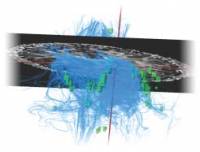Accueil » Recherche » Equipe Empenn U1228 INSERM-IRISA-UMR CNRS 6074 » Imaging biomarkers in brain pathologies

Extraction and exploitation of complex imaging biomarkers involve an imaging workflow processing which can be quite complex. This goes from image physics and image acquisition, image processing for quality control and enhancement, image analysis for features extraction and image fusion up to the final application which intend to demonstrate the capability of the image processing workflow to issue sensitive and specific markers of a given pathology.
In this context, our objectives in the recent period was directed toward three major methodological achievements and five main applications:
1. Medical image computing research topics:
– Image processing of scalar, vector or tensor fields
– Segmentation and labeling of brain structures from multidimensional data
– Feature detection and classification from multidimensional manifolds
2. Related projects and applications: Multiple Sclerosis, Parkinsonian disorders, Neuro pediatrics, Arterial Spin Labelling, 3D Morphometry of Hominid Endocasts
Research Areas
Image denoising of scalar, vector or tensor fields
A critical issue in the context of image restoration is the problem of noise removal while keeping the integrity of relevant image information. Denoising is a crucial step to increase image conspicuity and to improve the performances of all the processing needed for quantitative imaging analysis. We have proposed a series of methods based on an optimized blockwise version of the Non Local (NL) Means filter . If the performances of the NL-means filter have been already shown for 2D scalar images, the critical aspect of extending the method to 3D images was the computational burden and the adaptation of the noise model to the statistics of the image formation. To overcome this problem, we have proposed to reduce the computational complexity (dividing by a factor of 350 the computational time). A fully automated version of the blockwise NL-means filter has been performed, exhibiting the best state of the art denoising results without expensive computational burden. This was carried out for 1) regular sequences of MR images (T1-w, T2-w, FLAIR, PD, …) with Gaussian noise modeling, 2) for ultrasound (US) imaging, with a new Bayesian framework to design a NL-means filter adapted to a relevant ultrasound noise model, and 3) for Diffusion-Weighted MRI (DW-MRI) with high b-values (and thus low SNR), which noise is strictly Rician-distributed, which was successfully applied to regular DTI estimation and high angular resolution diffusion imaging (HARDI) or q-space imaging (QSI).
Segmentation and labeling of brain structures from multidimensional data
The major contributions in this domain concerned 1) the multiple objects segmentation with level sets on which we have proposed a new method to segment 3D structures with competitive level sets driven by a shape model and fuzzy control; 2) the multidimensional brain structures segmentation with spectral gradient and graph-cuts which was achieved by merging three or more different MRI sequences into a single RGB-like by using an optimal decomposition and a scale-space color spectral gradient operator optimized by a graph cuts paradigm; and 3) the labeling of Cortical Sulci using Multidimensional Scaling, which consists in a relational pattern matching with a supervised learning framework using multidimensional scaling (MDS) to recreate the structural relationship between sulci in an embedded space allowing 90% success rate for labeling brain sulci on normal subject and almost the same score for labeling sulci displaced by brain lesions.
Tools for estimation of asymmetries from multidimensional manifolds
We proposed a set of new generic automated processing tools to characterize the local asymmetries of anatomical structures (represented by surfaces) at an individual level, and within/between populations. The building bricks of this toolbox are: 1) a new algorithm for robust, accurate, and fast estimation of the symmetry plane of grossly symmetrical surfaces, and 2) a new algorithm for the fast, dense, non-linear matching of surfaces. This last algorithm was used both to compute dense individual asymmetry maps on surfaces, and to register these maps to a common template for population studies. We showed these two algorithms to be mathematically well grounded, and we provided some validation experiments. Then we propose a pipeline for the statistical evaluation of local asymmetries within and between populations.